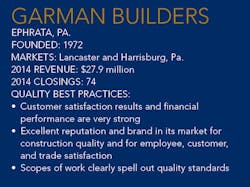For several years, Shawn Garman attended the International Builders’ Show and made a regular stop at the seminar where NHQ Award winners talked about their best practices and what they had gained by going through the award’s application process.
“I found it intriguing that all these companies of different sizes had suffered and gone through the same growth pains but learned a tremendous amount,” says the vice president and CFO of Garman Builders, in Ephrata, Pa.
Every year Garman picked up the 18-page application, yet despite good intentions, he and fellow owners, brothers Mike, president, and Jason, vice president of construction, were just too busy or not ready to take on the rigorous self-assessment.
The brothers grew up in home building. Shawn recalls being as young as 3 years old when his dad, Ivan, sat the boys on a countertop, using their weight to hold down the surface while he fastened it to the drawer tops. They worked full time in their father’s business after graduating from high school in the ’80s and ’90s, and know and have done all the tasks that their subcontractors do. By 2006, they switched from house-by-house construction to even-flow scheduling. Sales and staff grew, but for years Garman Builders’ written goals focused on sales yet didn’t address other aspects of the company. The brothers recognized that they needed a comprehensive, measurable program.
So this past year they hired a local consultant who walked them through exercises for developing a strategic plan—a criterion that NHQ Awards judges use to evaluate how well the drive for continuous improvement permeates an organization. Although they were builders by nature, the Garman brothers understood that their mindset had to change.
“We used to call ourselves builders, but as complicated as home building has gotten with regulations, codes, and finances, you now truly have to be a business professional. You can build a house. You can build a process. They’re not that different. It’s actually a lot of fun going through this application and seeing how far we’ve come,” Shawn says.
Mike Garman accepted that big-picture ideas are key, but he didn’t realize the importance of the company’s value, vision, and mission statements. “I think it just brought to the forefront that as we get larger and maybe have less contact with customers and subcontractors, that the core staff needs to be aligned with our values, vision, and mission,” he says. “I don’t know that I quite picked up on how important that was until we went through this process.”
The initial goal of strategic planning was to align the owners so that they row in the same direction. Going forward, the brothers intend to develop repeatable processes for sharing more planning responsibilities and soliciting feedback from employees and trades.
“Sure, our background is in home building,” Jason says. “We each have a high school education and went beyond that to a business degree, so we kind of self-developed. But when I look at what we’re doing today, it’s all about developing processes and procedures and working in everything and asking, ‘Do I have this spelled out clearly enough so that if I’m not here tomorrow, somebody knows the answer?’ If we can do that in everything we do, then I don’t have to come in tomorrow,” he quips.


